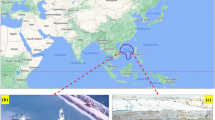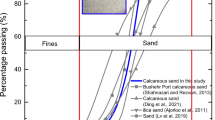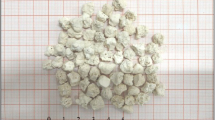Abstract
Studies show that the shear strength of angular-shaped calcareous sand is mainly affected by dilatancy, interparticle locking, and particle breakage. In the present study, a series of consolidated-drained triaxial compression tests on calcareous sands are carried out to investigate the strength impacts of dilatancy, interparticle locking, and particle breakage. It is found that as the stress level increases, the friction angle difference reflecting the effect of the particle breakage increases. In contrast, the friction angle difference reflecting the interparticle locking and dilatancy effect decreases gradually. Moreover, the critical stress ratio of the high-angled calcareous sands decreases, which may be attributed to particle breakage. The obtained results demonstrate that when the stress level exceeds a certain value, the critical stress ratio remains constant. Then the correlation between the particle breakage, interparticle locking, and dilatancy effects in the shear strength is studied. Finally, based on the performed analysis on energy dissipation in calcareous sands, a dilatancy model is proposed that covers the particle breakage effect. The performed analyses demonstrate that the proposed model can accurately explain the experimental data.
Similar content being viewed by others
Abbreviations
- a, b :
-
Test parameters
- a 1, b 1 :
-
Constant
- B g :
-
Breakage rate proposed by Marsal
- B p :
-
Breakage potential
- B r :
-
Relative breakage; Br/Bt/Bp
- \(B_{\rm{r}}^\prime\) :
-
Particle breakage rate proposed by Einav
- B t :
-
Total breakage
- D :
-
Dilatancy factor
- D max :
-
Maximum dilatancy factor
- E B :
-
Breakage energy
- e i :
-
Void ratio
- H :
-
Material parameter
- h :
-
Breakage hardness
- h c, h d :
-
Test parameters
- K cs :
-
R/D ratios when φ=φcs
- K f :
-
R/D ratios when φ=φfr
- K u :
-
R/D ratios when φ=φu
- M :
-
Material parameter
- M c :
-
q/p ratio at critical state
- M p :
-
Peak stress ratio
- m, n :
-
Test parameters
- m 1, m 2 :
-
Test parameters
- n b :
-
Breakage number
- n s :
-
Shape number
- p :
-
Mean effective stress
- p a :
-
Atmospheric pressure
- q :
-
Deviatoric stress
- R :
-
Principal stress ratio
- R 0 :
-
Overall roundness
- Rmax:
-
Maximum stress principal stress ratio
- ε s :
-
Shear strain
- ε v :
-
Volumetric strain
- ε 1 :
-
Axial strain
- η :
-
Stress ratio; η=q/p
- σ b :
-
Breakage effective stress
- σ dbi :
-
Threshold stress
- σ r :
-
Breakage reference stress
- σ 0, τ0 :
-
Effective octahedral normal and shear stresses
- σ 3 :
-
Confining pressure
- \({\sigma _3}^\prime ,\,\,{\sigma _1}^\prime\) :
-
Effective minor and major principal stresses, respectively
- φ b :
-
Friction angle difference reflected the effect of particle breakage; φb=φfb − φfr
- φ cs :
-
Critical state friction angle
- φ d :
-
Friction angle difference reflected the effect of dilatancy; φd=φp − φf
- φ f :
-
Friction angle including particle breakage and interparticle locking but excluding dilatancy
- φ fb :
-
Friction angle includes particle breakage but excludes dilatancy and interparticle locking
- φ fi :
-
Friction angle which contains interparticle locking but excludes dilatancy and particle breakage
- φ fr :
-
Friction angle which contains rearrangement and basic friction but excludes dilatancy
- φ i :
-
Friction angle difference reflected the effect of interparticle locking; φi=φf − φfb
- φ max :
-
Maximum friction angle calculated based on Mohr-Coulomb criterion when sample at failure
- φ mob :
-
Mobilized friction angle
- φ p :
-
Peak friction angle
- φ r :
-
Friction angle difference reflected the effect of particle rearrangement; φr=φfr − φu
- φ u :
-
Basic friction angle
- ψ max :
-
Maximum dilatancy angle
References
Alshibli KA, Sture S (2000) Shear band formation in-plane strain experiments of sand. Journal of Geotechnical and Geoenvironmental Engineering 126(6):495–503, DOI: https://doi.org/10.1061/(ASCE)1090-0241(2000)126:6(495)
Bandini V, Coop MR (2011) The influence of particle breakage on the location of the critical state line of sands. Soils and Foundations 51(4):591–600, DOI: https://doi.org/10.3208/sandf.51.591
Bolton MD (1986) The strength and dilatancy of sands. Geotechnique 36(1):65–78, DOI: https://doi.org/10.1680/geot.1986.36.1.65
Chan LCY, Page NW (1997) Particle fractal and load effects on internal friction in powders. Powder Technology 90:259–266, DOI: https://doi.org/10.1016/s0032-5910(96)03228-7
Chavez C, Alonso EE (2003) A constitutive model for crushed granular aggregates which includes suction effects. Soils and Foundations 43(4):215–227, DOI: https://doi.org/10.3208/sandf.43.4_215
Chen XB, Zhang JS (2016) Influence of relative density on dilatancy of clayey sand-fouled aggregates in large-scale triaxial tests. Journal of Geotechnical and Geoenvironmental Engineering 142(10):06016011, DOI: https://doi.org/10.1061/(asce)gt.1943-5606.0001542
Cho GC, Dodds J, Santamarina JC (2006) Particle shape effects on packing density, stiffness, and strength: Natural and crushed sands. Journal of Geotechnical and Geoenvironmental Engineering 132(5):591–602, DOI: https://doi.org/10.1061/(asce)1090-0241(2006)132:5(591)
Ciantia MO, O’Sullivan C (2020) Calculating the state parameter in crushable sands. International Journal of Geomechanics 20(7): 04020095, DOI: https://doi.org/10.1061/(asce)gm.1943-5622.0001707
Coop MR, Sorensen KK, Bodas-Freitas T, Georgoutos G (2004) Particle breakage during shearing of a carbonate sand. Geotechnique 54(3): 157–163, DOI: https://doi.org/10.1680/geot.54.3.157.36347
Dafalias YF, Manzari MT (2004) Simple plasticity sand model accounting for fabric change effects. Journal of Engineering Mechanics 130:622–634, DOI: https://doi.org/10.1061/(asce)0733-9399(2004)130:6(622)
Einav I (2007) Breakage mechanics—Part I: Theory. Journal of the Mechanics and Physics of Solids 55(6):1274–1297, DOI: https://doi.org/10.1016/j.jmps.2006.11.003
Guo GQ (1987) Experimental study on shear strength properties of coarse-grained. Journal of Hydraulic Engineering (5):59–65, DOI: https://doi.org/10.13243/j.cnki.slxb.1987.05.009 (in Chinese)
Guo WL, Chen L (2019) A stress-dilatancy relationship for rockfill incorporating particle breakage and intermediate principal-stress ratio. KSCE Journal of Civil Engineering 23(7):2847–2851, DOI: https://doi.org/10.1007/s12205-019-0279-8
Guo P, Su X (2007) Shear strength, interparticle locking, and dilatancy of granular materials. Canadian Geotechnical Journal 44:579–591, DOI: https://doi.org/10.1139/t07-010
Hardin BO (1985) Crushing of soil particles. Journal of Geotechnical Engineering 111(10):1177–1192, DOI: https://doi.org/10.1061/(asce)0733-9410(1985)111:10(1177)
Hattamleh OA, AlShalabi F, Qablan HA, Al-Rousan T (2010) Effect of grain crushing and bedding plane inclination on Aqaba sand behavior. Bull Eng Geol Environ 69:41–49, DOI: https://doi.org/10.1007/s10064-009-0238-6
Huang X, O’Sullivan C, Hanley KJ, Kwok CY (2014) Discrete-element method analysis of the state parameter. Geotechnique 64(12):954–965, DOI: https://doi.org/10.1680/geot.14.p.013
Huang J, Xu S, Hu S (2013) Effects of grain size and gradation on the dynamic responses of quartz sands. International Journal of Impact Engineering 59:1–10, DOI: https://doi.org/10.1016/j.ijimpeng.2013.03.007
Indraratna B, Salim W (2002) Modelling of particle breakage of coarse aggregates incorporating strength and dilatancy. Proceedings of Institute of Civil Engineers, London 155(4):243–252, DOI: https://doi.org/10.1680/geng.155.4.243.38691
Indraratna B, Sun Q, Nimbalkar S (2015) Observed and predicted behaviour of rail ballast under monotonic loading capturing particle breakage. Canadian Geotechnical Journal 52(1):73–86, DOI: https://doi.org/10.1139/cgj-2013-0361
Jia J, Zheng JX, Sun XJ (2021) The critical state parameters of sands from their image-based intrinsic properties. Acta Geotechnica 16:4081–4092, DOI: https://doi.org/10.1007/s11440-021-01280-z
Jia YF, Chi SC, Lin G (2009) Constitutive model for coarse granular aggregates incorporating particle breakage. Rock and Soil Mechanics 30(11):3261–3272, DOI: https://doi.org/10.3969/j.issn.1000-7598.2009.11.007 (in Chinese)
Jia YF, Xu B, Chi SC, Xiang B, Xiao D, Zhou Y (2019) Particle breakage of rockfill material during triaxial tests under complex stress paths. International Journal of Geomechanics 19(12):04019124, DOI: https://doi.org/10.1061/(asce)gm.1943-5622.0001517
Ladd RS (1978) Preparing test specimens using undercompaction. International Journal of Rock Mechanics and Mining Sciences & Geomechanics Abstracts 16(3):50, DOI: https://doi.org/10.1016/0148-9062(79)90502-3
Lee KL, Seed HB (1967) Drained characteristics of sands. Journal of the Soil Mechanics and Foundations Division 93(SM6):117–141
Liu MD, Airey DW, Indraratna B, Zhuang Z, Horpibulsuk S (2020b) An extended modified cam clay model for improved accuracy at low and high-end stress levels. Marine Georesources and Geotechnology 38(4):423–414, DOI: https://doi.org/10.1080/106411
Liu MC, Gao YF (2016) Constitutive modeling of coarse-grained materials incorporating the effect of particle breakage on critical state behavior in a framework of generalized plasticity. International Journal of Geomechanics 17(5):04016113, DOI: https://doi.org/10.1061/(asce)gm.1943-5622.0000759
Liu X, Li S, Lin L, Li TT, Yin JS (2021) Experimental study on the monotonic and cyclic behavior of carbonate sand in the South China Sea. KSCE Journal of Civil Engineering 25(9):3254–3263, DOI: https://doi.org/10.1007/s12205-021-1503-x
Liu Y, Liu H, Mao H (2018) The influence of rolling resistance on the stress-dilatancy and fabric anisotropy of granular materials. Granular Matter 20(1):1–16, DOI: https://doi.org/10.1007/s10035-017-0780-z
Liu HB, Zeng KF, Zou Y (2020a) Particle breakage of calcareous sand and Its correlation with Input energy. International Journal of Geomechanics 20(2):04019151, DOI: https://doi.org/10.1061/(asce)gm.1943-5622.0001541
Luo MX, Zhang JR, Liu XX (2021a) Dilatancy behaviors and equation of calcareous sand considering stress path and particle breakage, Chinese Journal of Geotechnical Engineering 43(8):1453–1462, DOI: https://doi.org/10.11779/CJGE202108010 (in Chinese)
Luo MX, Zhang JR, Liu XX, Xu DD (2021b) Critical state elastoplastic constitutive model of angular-shaped and fragile granular materials. Marine Georesources and Geotechnology 39(8):937–950, DOI: https://doi.org/10.1080/1064119X.2020.1785065
Marri A, Wanatowski D, Yu HS (2012) Drained behaviour of cemented sand in high pressure triaxial compression tests. Geomechanics and Geoengineering: An International Journal 7(3):1–16, DOI: https://doi.org/10.1080/17486025.2012.663938
Ning FW, Liu JM, Kong XJ, Zou DG (2020) Critical state and grading evolution of rockfill material under different triaxial compression tests. International Journal of Geomechanics 20(2):04019154, DOI: https://doi.org/10.1061/(asce)gm.1943-5622.0001550
Nouguier-Lehon C (2010) Effect of the grain elongation on the behaviour of granular materials in biaxial compression. Comptes Rendus Mecanique 338: 587–595, DOI: https://doi.org/10.1016/j.crme.2010.10.005
Reynolds O (1885) On the dilatancy of media composed of rigid particles in contact,with experimental illustrations. The London, Edinburgh, and Dublin Philosophical Magazine and Journal of Science 20(127): 468–481, DOI: https://doi.org/10.1080/14786448508627791
Rouse PC, Fannin RJ, Shuttle DA (2008) Influence of roundness on the void ratio and strength of uniform sand. Geotechnique 58(3):227–231, DOI: https://doi.org/10.1680/geot.2008.58.3.227
Rowe PW (1962) The stress-dilatancy relation for static equilibrium of an assembly of particles in contact. Proceedings of the Royal Society of London. Series A, Mathematical and Physical Sciences London, Serie A 269:500–527
Sadrekarimi A (2009) Development of a new ring shear apparatus for investigating the critical state of sands. PhD Thesis, University of Illinois, USA
Sadrekarimi A, Olson SM (2011) Critical state friction angle of sands. Geotechnique 61(9):771–783, DOI: https://doi.org/10.1680/geot.9.p.090
Shahnazari H, Salehzadeh H, Rezvani R, Dehnavi Y (2014) The effect of shape and stiffness of originally different marine soil grains on their contractive and dilative behavior. KSCE Journal of Civil Engineering 18(4):975–983, DOI: https://doi.org/10.1007/s12205-014-0286-8
Shinohara K, Oida M, Golman B (2000) Effect of particle shape on angle of internal friction by triaxial compression test. Powder Technology 107(1–2):131–136, DOI: https://doi.org/10.1016/s0032-5910(99)00179-5
Sun Y, Xiao Y, Zhou W, Liu HL (2022) Particle breakage and shape evolution of calcareous and quartz sands under compression. Chinese Journal of Geotechnical Engineering 44(6):1061–1068 (in Chinese)
Sukumaran B, Ashmawy AK (2001) Quantitative characterization of the geometry of discrete particles. Geotechnique 51(7):171–179, DOI: https://doi.org/10.1680/geot.51.7.619.51393
Terzaghi K, Peck RB, Mesri G (1996) Soil mechanics in engineering practice. 3rd ed. New York: John Wiley
Ueng TS, Chen TJ (2000) Energy aspects of particle breakage in drained shear of sands. Geotechnique 50(1):65–72, DOI: https://doi.org/10.1680/geot.2000.50.1.65
Wang S, Lei XW, Meng QS, Xu JL, Xie LF, Li YJ (2020a) Influence of particle shape on the density and compressive performance of calcareous sand. KSCE Journal of Civil Engineering 24(1):49–62, DOI: https://doi.org/10.1007/s12205-020-0145-8
Wang G, Wang ZN, Ye QG, Wei X (2020b) Particle breakage and deformation behavior of carbonate sand under drained and undrained triaxial compression. International Journal of Geomechanics 20(3): 04020012, DOI: https://doi.org/10.1061/(asce)gm.1943-5622.0001601
Wang XZ, Weng YL, Wang X, Chen WJ (2018) Interlocking mechanism of calcareous soil. Rock and Soil Mechanics 39(9):3113–3120, DOI: https://doi.org/10.16285/j.rsm.2017.2426 (in Chinese)
Wang LZ, Yin MG, Kong HL, Zhang HL (2022) Experimental study on breakage characteristics and energy dissipation of the crushed rock grains. KSCE Journal of Civil Engineering 26(3):1465–1478, DOI: https://doi.org/10.1007/s12205-022-1088-z
Wang X, Zhu CQ, Wang XZ, Qin Y (2019) Study of dilatancy behaviors of calcareous soils in a triaxial test. Marine Georesources and Geotechnology 37(9):1057–1070, DOI: https://doi.org/10.1080/1064119X.2018.1526236
Wei HZ, Zhao T, He JQ, Men QS, Wang XZ (2018) Evolution of particle breakage for calcareous sands during ring shear tests. International Journal of Geomechanics 18(2):04017153, DOI: https://doi.org/10.1061/(ASCE)GM.1943-5622.0001073
Wei HZ, Zhao T, Meng QS, Wang XZ, Zhang B (2020) Quantifying the morphology of calcareous sands by dynamic image analysis. International Journal of Geomechanics 20(4):04020020, DOI: https://doi.org/10.1061/(ASCE)GM.1943-5622.0001640
Wu Y, Cui J, Li N, Wang X, Wu YH, Guo SY (2020a) Experimental study on the mechanical behavior and particle breakage characteristics of hydraulic filled coral sand on a coral reef island in the South China Sea. Rock and Soil Mechanics 41(10):1–11, DOI: https://doi.org/10.16285/j.rsm.2020.0596 (in Chinese)
Wu EL, Zhu JG, Guo WL, Zhang ZL (2020b) Effect of gradation on the compactability of coarse-grained soils. KSCE Journal of Civil Engineering 24(2):356–364, DOI: https://doi.org/10.1007/s12205-020-1936-7
Xiao Y, Liu HL (2017) Elastoplastic constitutive model for rockfill materials considering particle breakage. International Journal of Geomechanics 17(1):04016041, DOI: https://doi.org/10.1061/(asce)gm.1943-5622.0000681
Xiao Y, Long LH, Evans TM, Zhou H, Liu HL, Stuedlein AW (2019) Effect of particle shape on stress-dilatancy responses of medium-dense sands. Journal of Geotechnical and Geoenvironmental Engineering 145(2):04018105, DOI: https://doi.org/10.1061/(asce)gt.1943-5606.0001994
Yang J, Luo XD (2015) Exploring the relationship between critical state and particle shape for granular materials. Journal of the Mechanics and Physics of Solids 84:196–213, DOI: https://doi.org/10.1016/j.jmps.2015.08.001
Yang J, Luo XD (2018) The critical state friction angle of granular materials: Does it depend on grading? Acta Geotechnica 13(3):535–547, DOI: https://doi.org/10.1007/s11440-017-0581-x
Yang J, Wei LM (2012) Collapse of loose sand with the addition of fines: The role of particle shape. Geotechnique 62(12):1111–1125, DOI: https://doi.org/10.1680/geot.11.p.062
Yang S, Shen X, Liu HL, Ge HY, Rui XX (2019) Gradation affects basic mechanical characteristics of chinese calcareous sand as airport subgrade of reefs. Marine Georesources and Geotechnology 38(6): 706–715, DOI: https://doi.org/10.1080/1064119X.2019.1614122
Yu FW (2018) Particle breakage in triaxial shear of a coral sand. Soils and Foundations 58(4):866–880, DOI: https://doi.org/10.1016/j.sandf.2018.04.001
Zhang XY, Cai YY, Wang ZB, Jiang YQ (2018) Fractal breakage and particle shape analysis for coral sand under high-pressure and one-dimensional creep conditions. Rock and Soil Mechanics 39(5): 1573–1580, DOI: https://doi.org/10.16285/j.rsm.2017.0763 (in Chinese)
Zhao JD, Guo N (2014) Rotational resistance and shear-induced anisotropy in granular media. Acta Mechanica Solida Sinica 27(1):1–14, DOI: https://doi.org/10.1016/s0894-9166(14)60012-4
Zhang JR, Luo MX (2020) Dilatancy and critical state of calcareous sand incorporating particle breakage. International Journal of Geomechanics 20(4):04020030, DOI: https://doi.org/10.1061/(ASCE)GM.1943-5622.0001637
Zhang JR, Luo MX, Peng WK Zhang BW (2021) Drained triaxial tests on mechanical properties of calcareous sand under various stress paths, Chinese Journal of Geotechnical Engineering 43(4):593–602, DOI: https://doi.org/10.11779/CJGE202104001 (in Chinese)
Zhou Y, Wang HB, Zhou B, Li JM (2018) DEM-aided direct shear testing of granular sands incorporating realistic particle shape. Granular Matter 20(3):1–12, DOI: https://doi.org/10.1007/s10035-018-0828-8
Acknowledgments
This work presented in this paper was funded by the National Natural Science Foundation of China (Grant No. 42172295), the Hubei Provincial Education Department Science and Technology Research Project (Grant No. Q20222701), and the project funded by of Natural Science Foundation of Xiaogan (Grant No. XGKJ2022010101). The authors would like to thank all the reviewers who participated in the review, as well as MJEditor (www.mjeditor.com) for providing English editing services during the preparation of this manuscript.
Author information
Authors and Affiliations
Corresponding author
Rights and permissions
About this article
Cite this article
Luo, M., Zhang, J., Liu, X. et al. Effect of Particle Breakage and Interlocking on Strength and Dilatancy Characteristics of Calcareous Sands. KSCE J Civ Eng 27, 3270–3284 (2023). https://doi.org/10.1007/s12205-023-1470-5
Received:
Revised:
Accepted:
Published:
Issue Date:
DOI: https://doi.org/10.1007/s12205-023-1470-5




